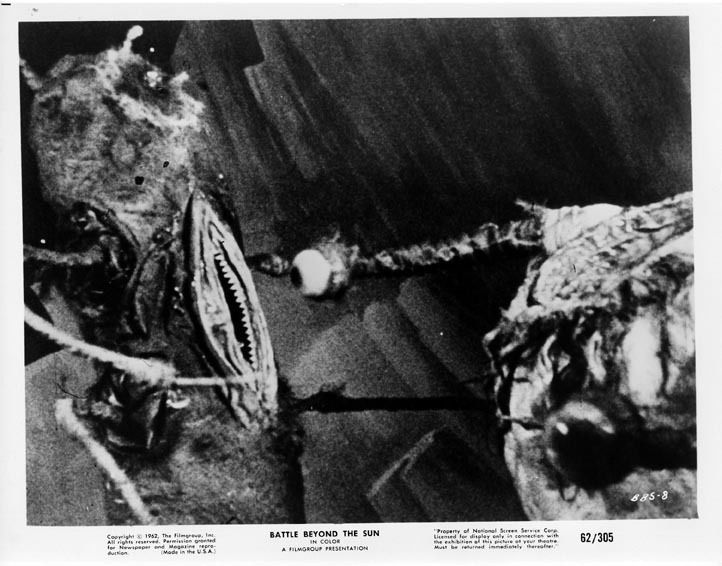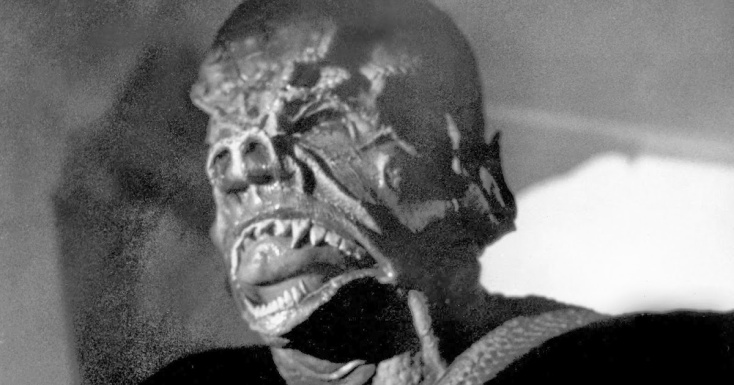Concluding our look at Roger Corman’s cannibalization of Soviet SF films.
Ruble-pinching Roger got his best ROI with Pavel Klushantsev’s Planeta Bur (Planet of Storms, 1962), which he cannibalized not once, but twice. Harrington’s makeover is far less comprehensive, adding expository scenes of Rathbone and Faith Domergue of This Island Earth (1955) fame, so Voyage to a/the [onscreen titles differ] Prehistoric Planet (1965)—sold directly to TV via AIP—is credited to “John Sebastian.” Billed as “Derek Thomas,” Peter Bogdanovich, uh, fleshed out Voyage to the Planet of Prehistoric Women (1966) with Mamie Van Doren leading the titular telepathic, amphibious Venusians; it is not be confused with Arthur C. Pierce’s forlorn Women of the Prehistoric Planet (1966).
I’ll occasionally see an example of what I call “scholarship” (one of my highest words of praise) that begs commendation, and Retromedia’s four-film The Roger Corman Russian Sci-Fi Collection—which Professor Tom, The Host with the Most™, whipped out for our most recent Movie Night faculty gathering in Queens—is one of them. The absence of Queen of Blood is compensated for with a subtitled print of Planeta Bur, enabling one to compare the original with both adulterated versions. A featurette, Being Mamie, offers a career-spanning interview with Van Doren, and if you look REALLY closely, you can spot Richard Matheson’s name at the bottom of the poster for The Beat Generation (1959).
Adapted by Klushantsev and Aleksandr Kazantsev from the latter’s novel, Planeta Bur opens with three Soviet “cosmic expedition starships” approaching Venus after a trip of some 140 million miles, only to have a meteorite destroy the Cappella, forcing a change in plans. To ensure sufficient fuel for the return trip, one ship must remain in orbit, so—leaving love interest Masha Ivanova (Kyunna Ignatova) aloft to process data and transmit it to Earth—Ivan Scherba (Yuri Sarantsev) descends in the Vega’s glider with Allan Kern (Georgi Tejkh) and his humanoid robot, John. Their mission is to find a suitable landing spot for the Sirius, returning therein, but they are forced down in a swamp after doing so.
Ilya Vassilievich Vershinin (Vladimir Yemelyanov), Alexey Alyosha (Gennadi Vernov), and Roman Bobrov (Georgi Zhzhyonov) set off from the Sirius in their ATV (above) to aid them, after Alexey is saved from a tentacled plant. Meanwhile (interestingly, in the transitions, scenes fade to red rather than black!), Ivan fends off lizard-men as Kern assembles John, and they make their way on foot, briefly sidelined by fever while taking refuge in a cave from a storm. Beset by pterodactyl-like creatures, the Sirius team submerges their ATV and finds a dragon statue with a ruby eye underwater, fueling discussions about possible inhabitants—indigenous or transplanted—and the melodious voices heard since arriving.
A red spot seen from orbit is revealed as a volcano, and John (above) tries to carry the men across the lava, although Isaac Asimov would cringe at the scene where they disconnect his self-protection program to stop him from lightening his load when his feet begin to melt. The ATV arrives just in time, and—like Soviet dwarves—the reunited men sing a happy song as they return to the Sirius, quickly changing their tune as a quake threatens to undermine it. Setting up a meteorological station while preparing to blast off, Alexey makes a crude tool out of a curious rock he had found, which breaks open to reveal a sculpted humanoid face; after they depart, we indistinctly see a robed figure reflected in the water of a pool…
“Sebastian” Americanized the names of the astronauts, but left those of the ships and the basic narrative intact as Professor Hartman (Rathbone) calls the shots from Lunar Station 7 (in lieu of Klushantsev’s offscreen and Earthbound mission control). Scenes of Masha were replaced by newly shot footage of Domergue (above), sporting a beehive hairdo and reeking of apathy, as Marsha Evans. Harrington said, “all I did was just shoot a couple of scenes of somebody in a space station [below]. The totality of [Voyage to the Prehistoric Planet] is the Soviet film dubbed, so that’s why it has another name on it. I really just did a couple of those scenes as a courtesy, but I don’t consider that I have anything to do with the film.”
Rathbone shot his scenes for both films back-to-back, utilizing the same set and costume. He “was very vital. He knew all of his lines; he was not in any way enfeebled. He was a man of great personal charm, and I really enjoyed talking to him between takes. It was a great privilege to work with him….[but Queen] was such a low-budget film, and we shot the whole thing in seven days. That meant that we were shooting non-union again, and I was shooting from early morning until very late at night….[which] was a strain on him, and he wasn’t paid sufficient overtime, so he was very upset about that. I had nothing to do with that, of course; I was just determined to shoot the film to the best of my ability…”
Prehistoric Women gets the deluxe widescreen treatment; Retromedia founder/Corman cohort Fred Olen Ray joins David DeCoteau for a commentary, and even reproduces the French photo novel La Planète des Tempêtes. Pilfering the space-exploration prologue from Battle Beyond the Sun, “Thomas” maintains Harrington’s dubbing and names, but repurposes the Planeta Bur footage sans female astronaut, so “Marsha” is the “code name for Earth control.” Bogdanovich narrates the film, presented as a flashback by Andre (né Alexey), while the three starships now represent separate missions, with the third sent to rescue the second, refueling at U.S. space station Texas via more chunks of Nebo Zovyot.
It is not until 33 minutes in that we first glimpse Moana (Van Doren) and her “sisters,” including Margot Hartman—who appeared in her husband Del Tenney’s Stamford-shot Curse of the Living Corpse (1964)—as Mayaway. They are first seen draped on a rocky shore like so much jetsam (above), clad in frilly white bell-bottoms and scallop-shell brassieres; with voiceovers instead of spoken dialogue, the actresses need do little but stare into the camera with expressions ranging from intent to vacant. Seeking to avenge the death of their pterodactyl-like “god,” killed by the humans, they incite the volcanic eruption and the destabilization that threatens the takeoff, then erect a lava-covered John in his place (below).
Ray’s commentary with fellow director DeCoteau is replete with entertaining anecdotes about Corman and the wild world of low-budget filmmaking, although concerning these cinematic examples of détente, it told me little I did not know. Women occupies a modest percentage of Being Mamie, created in 2003 for a stand-alone DVD, but it’s a fun way to, um, round out the set. The “Platinum Powerhouse” holds forth irreverently on everything from endless comparisons with Monroe and Mansfield—both of whom she has outlived for more than half a century—to her work with exploitation legend Albert Zugsmith (e.g., that Matheson misfire) and in the schlock classic The Navy vs. the Night Monsters (1966; below).
















